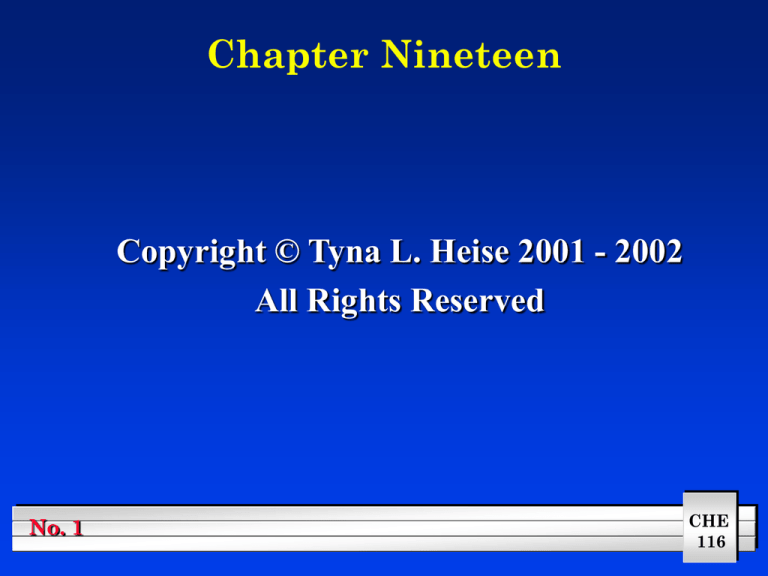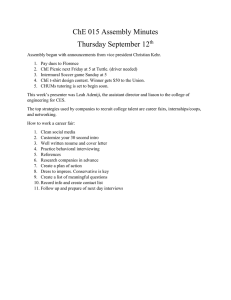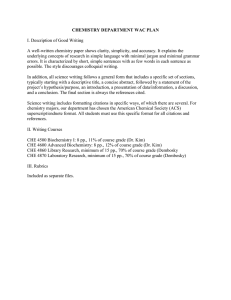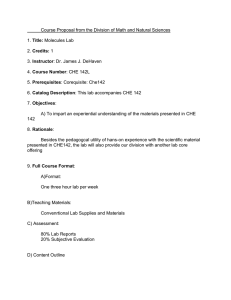
Chapter Nineteen
Copyright © Tyna L. Heise 2001 - 2002
All Rights Reserved
No. 1
CHE
116
Spontaneous Processes
Understanding and designing chemical
reactions:
How rapidly does the reaction proceed?
- reaction rates
- controlled by a factor related to
energy
- the lower the activation energy,
the faster the reaction proceeds
No. 2
CHE
116
Spontaneous Processes
How far toward completion will the
reaction go?
- equilibrium constants
- depends on rates of forward and
reverse reactions
- equilibrium should also be
dependent on energy in some way
due to dependence on reaction
rates
No. 3
CHE
116
Spontaneous Processes
Chemical thermodynamics is the relationship
between equilibrium and energy.
First Law of Thermodynamics: for a
reaction that occurs at constant
pressure, the enthalpy change equals
the heat transferred between the system
and its surroundings
Energy is conserved!!
* Enthalpy is important in helping us
determine if a reaction will proceed!
No. 4
CHE
116
Spontaneous Processes
Spontaneous Processes:
energy is neither created nor destroyed
in any process, energy can only be
transferred or converted from one form to
another
DE = q + w
a spontaneous process occurs without
any outside intervention as energy is
conserved
No. 5
CHE
116
Spontaneous Processes
No. 6
CHE
116
Spontaneous Processes
Spontaneous Processes:
temperature is going to effect the
spontaneity of a process
if discussing a phase change, at the
temperature of the phase change, the
phases compete for spontaniety, and
neither is said to win over the other
No. 7
CHE
116
Spontaneous Processes
Sample exercise: Under 1 atm pressure,
CO2(s) sublimes at -78°C. Is the
transformation of CO2(s) to CO2(g) a
spontaneous process at -100°C?
No. 8
CHE
116
Spontaneous Processes
Sample exercise: Under 1 atm pressure,
CO2(s) sublimes at -78°C. Is the
transformation of CO2(s) to CO2(g) a
spontaneous process at -100°C?
*No, if the temp had been higher it
would change phase spontaneously, but lower
than the sublimation point favors the reverse,
so the solid remains a solid.
No. 9
CHE
116
Spontaneous Processes
Reversible and Irreversible Processes:
State functions: define a state and do not
depend upon the pathway
temperature
internal energy
enthalpy
No. 10
CHE
116
Spontaneous Processes
Reversible and Irreversible Processes:
Reversible processes is a unique way for
a system to change its state, than go back
to its state by following the exact same
path but in the opposite direction
phase changes at constant temp
only one specific value of q (heat)
system in equilibrium
No. 11
CHE
116
Spontaneous Processes
Reversible and Irreversible Processes:
Irreversible processes cannot be simply
restored to their original state using the
same path, it may be forced to go back,
but by a different pathway
phase changes at different temps
two q values need to be established
qforward and qreverse
any spontaneous reaction
No. 12
CHE
116
Spontaneous Processes
Thermodynamics can tell us
direction of reaction
extent of reaction
NOT
speed of reaction
No. 13
CHE
116
Entropy and the 2nd Law
Spontaniety depends upon two factors
Enthalpy (DH): heat of reaction
exothermic normally spontaneous
endothermic normally NOT spontaneous
Entropy (DS): disorder of the system
natural law indicates reactions go in the
direction that leads to more disorder
No. 14
CHE
116
Entropy and the 2nd Law
The Spontaneous Expansion of a Gas:
When the stopcock is opened,
the gas will spontaneously
flow to fill the empty half,
but
it WILL NOT flow backward
without work being done on
the system.
No. 15
CHE
116
Entropy and the 2nd Law
The Spontaneous Expansion of a Gas:
Gas expands because of the tendency for the
molecules to ‘spread out’ among the different
arrangements that they can take.
No. 16
CHE
116
Entropy and the 2nd Law
Entropy: measurement of randomness or
chaos
melting ice
dissolving salts
The more disordered or random a system,
the larger its entropy
No. 17
CHE
116
Entropy and the 2nd Law
Sample exercise: Indicate whether each of
the following reactions produces an increase
or decrease in the entropy of the system:
a) CO2(s) CO2(g)
No. 18
CHE
116
Entropy and the 2nd Law
Sample exercise: Indicate whether each of
the following reactions produces an increase
or decrease in the entropy of the system:
a) CO2(s) CO2(g)
Entropy increases
No. 19
CHE
116
Entropy and the 2nd Law
Sample exercise: Indicate whether each of
the following reactions produces an increase
or decrease in the entropy of the system:
b) CaO(s) + CO2(g) CaCO3(s)
No. 20
CHE
116
Entropy and the 2nd Law
Sample exercise: Indicate whether each of
the following reactions produces an increase
or decrease in the entropy of the system:
b) CaO(s) + CO2(g) CaCO3(s)
Entropy decreases
No. 21
CHE
116
Entropy and the 2nd Law
Entropy: measurement of randomness or
chaos
state function
for a process that occurs at constant
temperature, the entropy change is
dependent on the heat transferred during the
reverse of the reaction (qrev)
DS = qrev/T
No. 22
CHE
116
Entropy and the 2nd Law
Sample exercise: The normal boiling point of
ethanol, C2H5OH, is 78.3°C, and its molar
enthalpy of vaporization is 38.56 kJ/mol.
What is the change in entropy when 25.8 g of
C2H5OH(g) at 1 atm pressure condenses to
liquid at the normal boiling point?
No. 23
CHE
116
Entropy and the 2nd Law
Sample exercise: The normal boiling point of
ethanol, C2H5OH, is 78.3°C, and its molar
enthalpy of vaporization is 38.56 kJ/mol.
What is the change in entropy when 25.8 g of
C2H5OH(g) at 1 atm pressure condenses to
liquid at the normal boiling point?
DS = qrev/T
No. 24
CHE
116
Entropy and the 2nd Law
Sample exercise: The normal boiling point of
ethanol, C2H5OH, is 78.3°C, and its molar
enthalpy of vaporization is 38.56 kJ/mol.
What is the change in entropy when 25.8 g of
C2H5OH(g) at 1 atm pressure condenses to
liquid at the normal boiling point?
DS = qrev/T
qrev = DHvap
= 38.56kJ/mol
T = 351.45 K
No. 25
CHE
116
Entropy and the 2nd Law
Sample exercise: The normal boiling point of
ethanol, C2H5OH, is 78.3°C, and its molar
enthalpy of vaporization is 38.56 kJ/mol.
What is the change in entropy when 25.8 g of
C2H5OH(g) at 1 atm pressure condenses to
liquid at the normal boiling point?
DS = qrev/T
38.56kJ 1000 J 1 mol
mol 1 kJ 46 g
T = 351.45 K
No. 26
CHE
116
Entropy and the 2nd Law
Sample exercise: The normal boiling point of
ethanol, C2H5OH, is 78.3°C, and its molar
enthalpy of vaporization is 38.56 kJ/mol.
What is the change in entropy when 25.8 g of
C2H5OH(g) at 1 atm pressure condenses to
liquid at the normal boiling point?
DS = qrev/T
838.26 J/g * 25.8 g =
-21627 J
T = 351.45 K
No. 27
CHE
116
Entropy and the 2nd Law
Sample exercise: The normal boiling point of
ethanol, C2H5OH, is 78.3°C, and its molar
enthalpy of vaporization is 38.56 kJ/mol.
What is the change in entropy when 25.8 g of
C2H5OH(g) at 1 atm pressure condenses to
liquid at the normal boiling point?
DS = qrev/T
= -21627 J/351.45 K
= -61.5 J/K
No. 28
CHE
116
Entropy and the 2nd Law
Second law of Thermodynamics: In any
reversible process, DSuniv = 0. In any
irreversible reaction, DSuniv >0.
DSuniv = DSsys + DSsurr
In an isolated system, just the entropy of the
system is considered.
No. 29
CHE
116
Molecular Interpretation
On the microscopic level, the number of gas
molecules can be directly related to the
amount of entropy in a system.
The more gas molecules present, the
higher the entropy value
a phase change that increases the
number of gas molecules would increase
entropy
a phase change that decreases the
number of gas molecules would decrease
entropy
No. 30
CHE
116
Molecular Interpretation
Three moles of gas combine to form two
moles of gas, thus decreasing the number of
molecules.
No. 31
CHE
116
Molecular Interpretation
Degrees of freedom
creating new bonds decreases the
freedom of movement atoms may have
had.
3 degrees
motion in one direction,
translational movement
vibrational movement
spinning, rotational movement
No. 32
CHE
116
Molecular Interpretation
Figure 19.12
No. 33
CHE
116
Molecular Interpretation
Sample exercise: Choose the substance with
the greatest entropy in each case:
1 mol of H2(g) at STP or 1 mol of H2(g) at
100°C and 0.5 atm.
No. 34
CHE
116
Molecular Interpretation
Sample exercise: Choose the substance with
the greatest entropy in each case:
1 mol of H2O(s) at 0°C or 1 mol of H2O(l) at
25°C.
No. 35
CHE
116
Molecular Interpretation
Sample exercise: Choose the substance with
the greatest entropy in each case:
1 mol of H2(g) at STP or 1 mol of SO2(g) at
STP.
No. 36
CHE
116
Molecular Interpretation
Sample exercise: Choose the substance with
the greatest entropy in each case:
1 mol of N2O4(g) at STP or 2 mol of NO2(g) at
STP.
No. 37
CHE
116
Molecular Interpretation
Sample exercise: Predict whether is DS is
positive or negative in each of the following
processes:
HCl(g) + NH3(g) NH4Cl(s)
No. 38
CHE
116
Molecular Interpretation
Sample exercise: Predict whether is DS is
positive or negative in each of the following
processes:
2SO2(g) + O2(g) 2SO3(s)
No. 39
CHE
116
Molecular Interpretation
Sample exercise: Predict whether is DS is
positive or negative in each of the following
processes:
cooling of nitrogen gas from 20°C
to -50°C
No. 40
CHE
116
Calculation of Entropy Changes
Entropy Calculations:
no easy method for measuring entropy
experimental measurements on the
variation of heat capacity with
temperature can give a value known as
absolute entropy
zero point of reference for perfect
crystalline solids
tabulated as molar quantities, J/mol-K
No. 41
CHE
116
Calculation of Entropy Changes
Entropy differs from enthalpy
standard molar entropies are not 0
entropies of gases are greater than those
of liquids and solids
entropies increase with molar mass
entropies increase with number of atoms
in formula
DS° = nS(products) - mS(reactants)
No. 42
CHE
116
Gibbs Free Energy
Spontaneity involves both thermodynamic
concepts: entropy and enthalpy
DG = DH – TDS
G = Gibbs Free Energy
H = Enthalpy
T = Temperature (K)
S = Entropy
No. 43
CHE
116
Gibbs Free Energy
Gibbs Free Enegry
If DG is negative, the reaction is spontaneous and
proceeds in the forward direction
If DG is zero, the reaction is at equilibrium
If DG is positive, the reaction is nonspontaneous
and proceeds in the reverse direction
No. 44
CHE
116
Gibbs Free Energy
Gibbs Free Enegry
State function
Table 19.3
No. 45
CHE
116
Gibbs Free Energy
Sample exercise: By using data from Appendix C,
Calculate DG at 298 K for the combustion of
methane:
CH4(g) + 2O2(g) CO2(g) + 2H2O(g)
No. 46
CHE
116
Gibbs Free Energy
Sample exercise: By using data from Appendix C,
Calculate DG at 298 K for the combustion of
methane:
CH4(g) + 2O2(g) CO2(g) + 2H2O(g)
-50.8
0
-394.4 2(-228.57)
No. 47
CHE
116
Gibbs Free Energy
Sample exercise: By using data from Appendix C,
Calculate DG at 298 K for the combustion of
methane:
CH4(g) + 2O2(g) CO2(g) + 2H2O(g)
-50.8
0
-394.4
2(-228.57)
DG = products - reactants
No. 48
CHE
116
Gibbs Free Energy
Sample exercise: By using data from Appendix C,
Calculate DG at 298 K for the combustion of
methane:
CH4(g) + 2O2(g) CO2(g) + 2H2O(g)
-50.8
0
-394.4
2(-228.57)
DG = products – reactants
(-394.4 + 2(-228.57)) – (-50.8 + 0)
No. 49
CHE
116
Gibbs Free Energy
Sample exercise: By using data from Appendix C,
Calculate DG at 298 K for the combustion of
methane:
CH4(g) + 2O2(g) CO2(g) + 2H2O(g)
-50.8
0
-394.4 2(-228.57)
DG = products – reactants
(-394.4 + 2(-228.57)) – (-50.8 + 0)
-800.7
No. 50
CHE
116
Gibbs Free Energy
Sample exercise: Consider the combustion of
propane to form CO2(g) and H2O(g) at 298K.
Would you expect DG to be more negative or less
negative than DH?
No. 51
CHE
116
Gibbs Free Energy
Sample exercise: Consider the combustion of
propane to form CO2(g) and H2O(g) at 298K.
Would you expect DG to be more negative or less
negative than DH?
more negative, using Gibbs Free Enegry
formula, more moles of gas being produced would
be increasing entropy, +DS,
No. 52
CHE
116
Free Energy and Temperature
Table 19.4
No. 53
CHE
116
Free Energy and Temperature
Sample exercise: Using standard enthalpies of
formation and standard entropies in Appendix C,
calculate DH and DS at 298 K for the following
reaction:
2SO2(g) + O2(g) 2SO3(g)
No. 54
CHE
116
Free Energy and Temperature
Sample exercise: Using standard enthalpies of
formation and standard entropies in Appendix C,
calculate DH and DS at 298 K for the following
reaction:
2SO2(g) + O2(g) 2SO3(g)
2(-296.9) 0
2(-395.2)
DH = 2(-395.2) - 2(-296.9) = -196.6 kJ
No. 55
CHE
116
Free Energy and Temperature
Sample exercise: Using standard enthalpies of
formation and standard entropies in Appendix C,
calculate DH and DS at 298 K for the following
reaction:
2SO2(g) + O2(g) 2SO3(g)
2(248.5) 205.0
2(256.2)
DS = 2(256.2) – (2(248.5)+205.0) = -189.6 J
No. 56
CHE
116
Free Energy and Temperature
Sample exercise: Using the values obtained,
estimate DG at 400 K
DG = DH – TDS
No. 57
CHE
116
Free Energy and Temperature
Sample exercise: Using the values obtained,
estimate DG at 400 K
DG = DH – TDS
= -196.6 kJ – 400(-0.1896 kJ)
= -120.8
No. 58
CHE
116
Free Energy and the
Equilibrium Constant
2 other important ways free energy is a powerful
tool
Tabulate free energy under nonstandard
conditions
Directly relate free energy to equilibrium
constants
No. 59
CHE
116
Free Energy and the
Equilibrium Constant
Tabulate free energy under nonstandard
conditions
DG = DG° + RTlnQ
R = 8.314 J/mol-K
T = temperature K
Q = reaction quotient
No. 60
CHE
116
Free Energy and the
Equilibrium Constant
Sample exercise: Calculate DG at 298 K for
the reaction of nitrogen and hydrogen to form
ammonia if the reaction mixture consists of 0.50
atm N2, 0.75 atm H2, and 2.0 atm NH3.
DG = DG° + RTlnQ
No. 61
CHE
116
Free Energy and the
Equilibrium Constant
Sample exercise: Calculate DG at 298 K for
the reaction of nitrogen and hydrogen to form
ammonia if the reaction mixture consists of 0.50
atm N2, 0.75 atm H2, and 2.0 atm NH3.
DG = DG° + RTlnQ
2(-16.6) + 0.008314(298)ln(2.02/0.50(0.753))
-26.0 kJ
No. 62
CHE
116
Free Energy and the
Equilibrium Constant
At equilibrium, DG is equal to 0 so…
DG° = -RTlnKeq
DG° negative: K > 1
DG° zero : K = 1
DG° positive: K < 1
Keq = e-DG°/RT
No. 63
CHE
116




